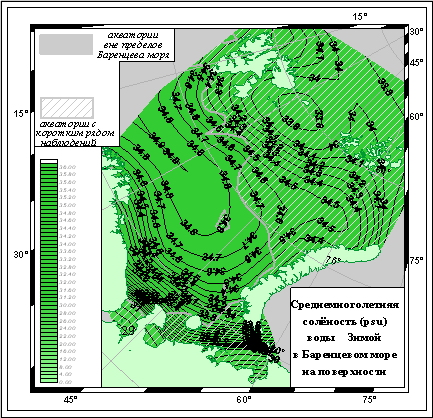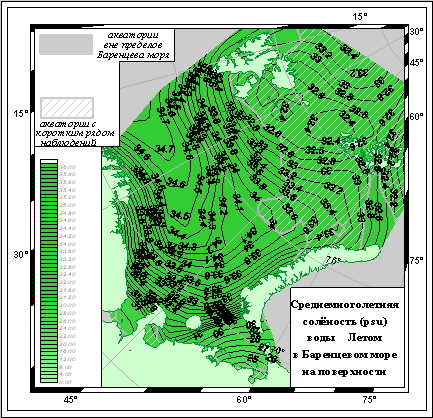Salinity of the Barents Sea and its water exchange
How salty is the Barents Sea, which affects the salinity of its waters. What determines the salinity of the Barents Sea?
Salinity of the Barents Sea
The salinity of the Barents Sea is determined primarily by the intensity of its water exchange with the surrounding basins, since the volume of these waters is more than two orders of magnitude greater than the other components of the freshwater balance. Atlantic waters have a particularly strong influence. Their influx on the western border is, according to various estimates, from 49 to 74 thousand km3/year. On the northern and northeastern border, the incoming and outgoing components of water exchange are the least reliable and, according to work /6/, amount to 5-10 thousand km3/year; their resulting amount, equal to 500 km3/year, is directed into the Barents Sea; in the Kara Gate Strait it is directed from the Barents Sea to the Kara Sea and amounts to 20 thousand km3/year. As a result, 2/3 of the sea area is under the influence of Atlantic waters and even on the sea surface the water salinity exceeds 34‰, amounting to 35‰ in the core (73o N, 20-35o E). In the rest of the Barents Sea, salinity fluctuates between 32-34 ‰.
The greatest values of desalination occur in the southeast of the sea, where desalinated White Sea waters are carried out (31-33 ‰) and the bulk of continental waters enter.


Figure: Average long-term salinity of surface water in summer and winter.
The maximum salinity of the Barents Sea on the surface (35‰) is observed in its southwestern part (the North Cape Trench), where salty Atlantic waters pass and where ice does not form or melt. To the north and south, salinity drops to 34.5‰ due to melting ice. The waters in the southeastern part of the sea are even more desalinated (32-33‰), where the melting of ice is combined with a powerful influx of fresh water from the land.
Changes in salinity on the surface of the Barents Sea occur not only from place to place, but also from season to season. In winter, throughout the Barents Sea, salinity is about 35‰, in the southeastern part - 32.5 - 33‰, since at this time of year the influx of Atlantic waters increases and intensive ice formation occurs. In spring, high salinity values remain almost everywhere. Only a narrow coastal strip near the Murmansk coast and in the Kanin-Kolguevsky region has low salinity: desalination here is caused by a gradually increasing continental runoff. In summer, the influx of Atlantic waters decreases, the ice melts, river water spreads far into the sea, so salinity decreases everywhere. In the second half of the season it drops below 35‰ everywhere. In the southwestern part, salinity is 34.5‰, and in the southeastern part it is 29‰, and sometimes 25‰. In autumn, salinity remains low throughout the sea for some time. But due to a decrease in river flow and the onset of ice formation, the salinity increases.
Salinity off the coast of Novaya Zemlya in winter and spring is 34.5‰, in summer and autumn it drops to 33.5-34.0‰ or less, which can be explained by both a general summer decrease in salinity in the southeast of the Barents Sea and a significant influx of highly desalinated waters of the Kara Sea with the current Litke.
In the northern part of the Barents Sea, the water mass has a salinity similar to the Arctic water mass (32-34 ‰); In summer, its salinity decreases further due to melting ice. Note that ice processes are reflected only in seasonal changes in salinity; average annual salinity values do not depend on ice, because There is no obvious annual runoff or influx of ice at the sea's boundaries. Salinization during ice formation does not lead to a noticeable increase in salinity at the surface, because Ice formation is accompanied by intense convection.
The annual variability of salinity in the Barents Sea occurs mainly in the surface layer. In the seasonal thermocline and below it is practically absent. In the Atlantic water mass, the standard deviation of average monthly salinity values is 0.1 ‰, in the southeast of the sea in the surface layer -1.0 ‰. Seasonal fluctuations in salinity in the Atlantic water mass occur due to a summer decrease in salinity when precipitation exceeds evaporation; in other areas of the sea they are additionally caused by ice melting, and in the southeast of the sea, mainly by river runoff and the White Sea drainage current. The latter area is distinguished by a special salinity regime: a vast zone of desalinated waters is formed here, concentrated in a thin layer (0-10 m), as a result of which the vertical salinity gradient in the summer months exceeds 1.0% / m and a jump layer is formed; a seasonal halocline arises, similar to the seasonal thermocline and enhancing the density stratification of waters. With a decrease in river flow and an increase in wind mixing (in August-November), the water salinity quickly increases and, therefore, summer freshening has less of an impact on ice processes than, for example, in the Kara Sea, where the salinity of surface waters is lower at the time of ice formation.
The salinity of the Barents Sea is distributed differently with depth, which is associated with the bottom topography, Influx of Atlantic and river waters. In most areas of the Barents Sea, salinity increases from 34‰ at the surface to 35.1‰ at the bottom. Over underwater elevations, the vertical changes in salinity are even smaller. The distribution of salinity in depth varies little from season to season. In summer, the surface layer is desalinated, and an increase begins from a horizon of 25-30 m. In winter, the jump smoothes out. Salinity values vary within significantly larger limits with depth in the southeastern part of the sea. The difference in salinity on the surface and at the bottom can reach several ppm. Seasonal changes in the vertical distribution of salinity are also clearly visible in this area. In winter, salinity is almost equalized throughout the entire water column. In spring, river waters begin to desalinate the surface layer. In summer, its desalination increases due to melted ice, so between the horizons of 10 and 25 m a sharp jump in salinity is formed. In autumn, a reduction in runoff and ice formation cause an increase in salinity and its equalization in depth.
Features of the vertical distribution of salinity in the western, northern, Novaya Zemlya and northeastern regions are presented in Fig. 6.
In contrast to seasonal variability, interannual variability in Barents Sea salinity depends more on fluctuations in river flow than on other components of the freshwater balance.